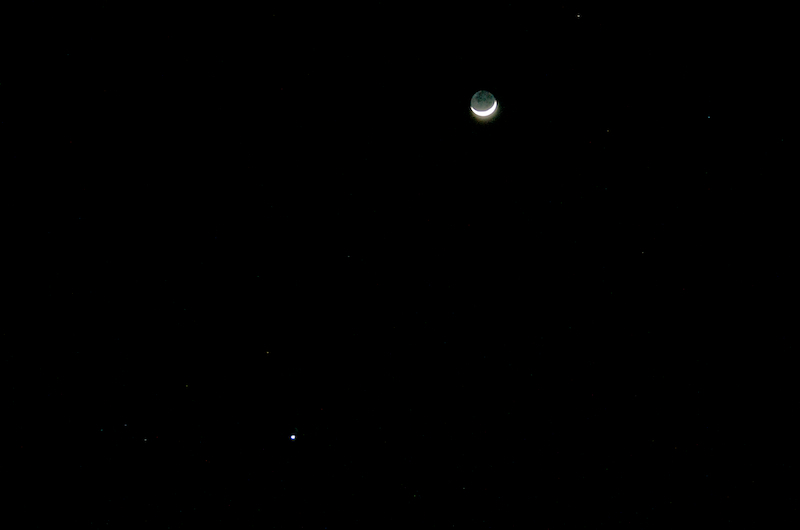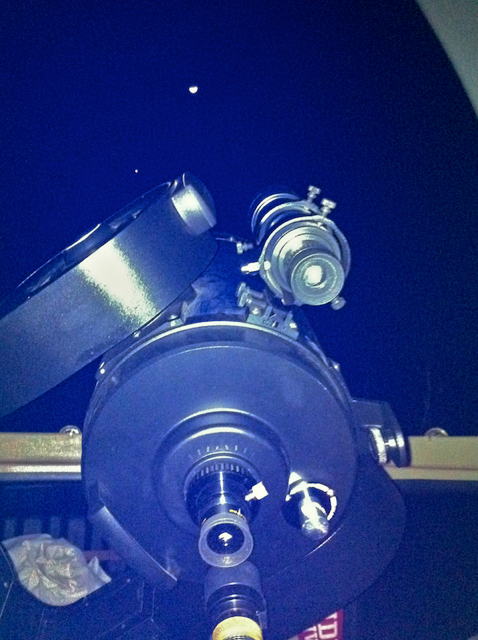
Venus & Moon, NGC278, NGC1977, M67, NGC2775, NGC3521
Posted: 27 January 2012
I was reading the March 2012 issue of Sky and Telescope magazine yesterday when I noticed something in the full-page ad from JMI. In the middle of the ad was this:
Click the image above to read my review.
I opened the observatory, Thursday, 26 January, at 1831 MST, 63°F. There were a few clouds low in the northwestern sky but they were not expected to become a problem. The replacement HH:MM:SS clock was still working. At 1835 MST, viewed the moon at 77X in the 8" LX200-ACF. Then took some photos of Venus and the crescent moon. This one was taken with the D7000 DSLR, f/4.5, 1/10sec, 82mm, ISO 500:

Earthshine is visible in the photo. This photo was taken with the iPhone 4 and shows the telescope pointing at Venus and the moon:

I then did some iPhone lunar imaging, afocal 26mm eyepiece, MX-1 afocal adapter, using some software that I'm testing for an upcoming review. I wanted to see how well the software would do on Earthshine. Here's one image:

At 1906 MST, I did some lunar observing at 206X. At 1920 MST, I took a quick look at Jupiter, 206X and 77X. I then slewed to NGC278, a small faint galaxy in the constellation of Cassiopeia. I wanted to retake some images with better guiding. The galaxy was faintly visible against the moonlight sky at 1924 NST. I began setting up for imaging. I mounted the D7000 DSLR at prime focus using the Off-Axis Guider. I did a focus test on the star Alpha Andromeda using the Bahtinov Mask. I went back to NGC278 and began looking for a guide star. Once I found one, I did a framing test exposure (1 minute, ISO 6400). I then began waiting for the moon to get lower in the sky before beginning to image. At 2055 MST, I began imaging. I did 5 and 10 minute, ISO 6400, guided exposures. This is the 10 minute exposure, slightly cropped from the full-frame image:

Next was NGC1977, the Running Man Nebula in Orion. I did several framing test exposures while searching for a good guide star. I eventually found a nice bright star to use and did 5 and 10 minute, ISO 6400, guided exposures. This is the 10 minute exposure, full-frame:

At 2144 MST, slewed to M67 (open cluster). This star cluster is a possible, but not probable, birthplace for our sun. This is a slightly cropped, 1 minute, ISO 6400, unguided exposure:

I ended imaging at 2156 MST and removed the camera from the telescope. I viewed NGC3521 (galaxy) at 77X. It was just rising over the hill to the east. I then went back to M67 for a quick look at 77X. I then viewed NGC1535 (plantary nebula) and NGC2775 (spiral galaxy). At 2222 MST, I remounted the camera on the telescope and did a focus test on the star Regulus. Slewed to NGC2775 (spiral galaxy), searched for a guide star and did some framing test exposures. The star I eventually found was very faint but I used it anyway. This is a slightly cropped, 5 minute, ISO 6400, guided exposure:

At 2256 MST, slewed to NGC3521 (galaxy) and began waiting for it to rise higher in the sky. While waiting I searched for a guide star and did some framing test exposures. At 0015 MST, I began guided imaging for 5 and 10 minute, ISO 6400, exposures. This is the 10 minute exposure, slightly cropped:

I ended imaging at 0035 MST. At 0043 MST, I viewed Mars at 77X. Seeing was not very good but I could occasionally get nice views at 206X and 354X. The North Polar Ice Cap was easily seen even with the bad seeing. Some dark areas on the planet would sometimes be seen.
Closed the observatory at 0100 MST, 52°F. A good 6.5 hour session at Cassiopeia Obervatory.
I recently posted some photos from my time in the United States Air Force when I flew the A-7D jet fighter. While not astronomy related, I hope you will enjoy them.
Go to the previous report.
Return to the Cassiopeia Observatory Welcome Page.